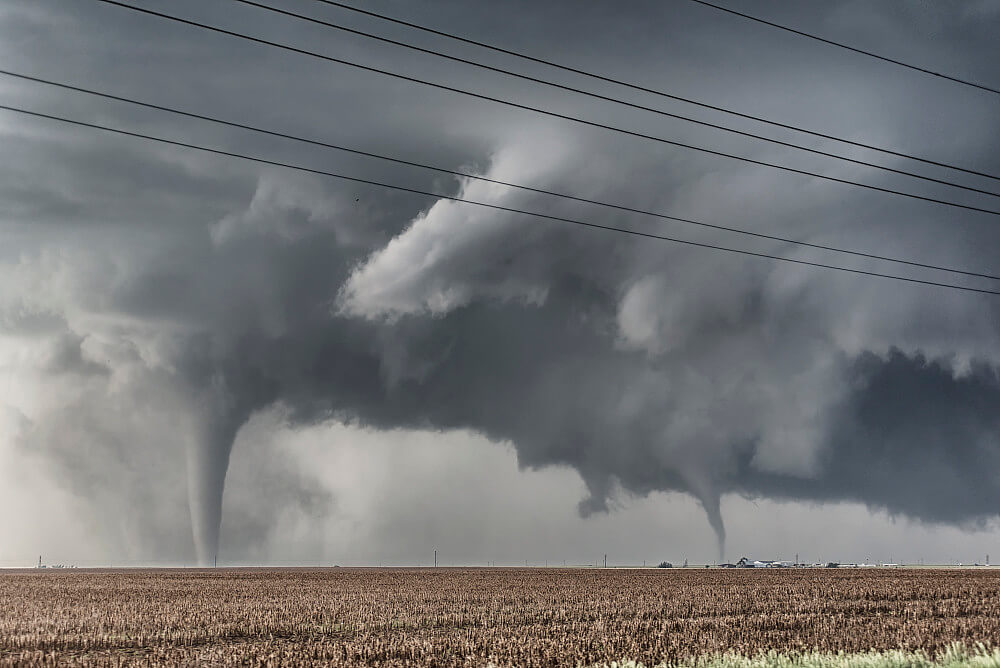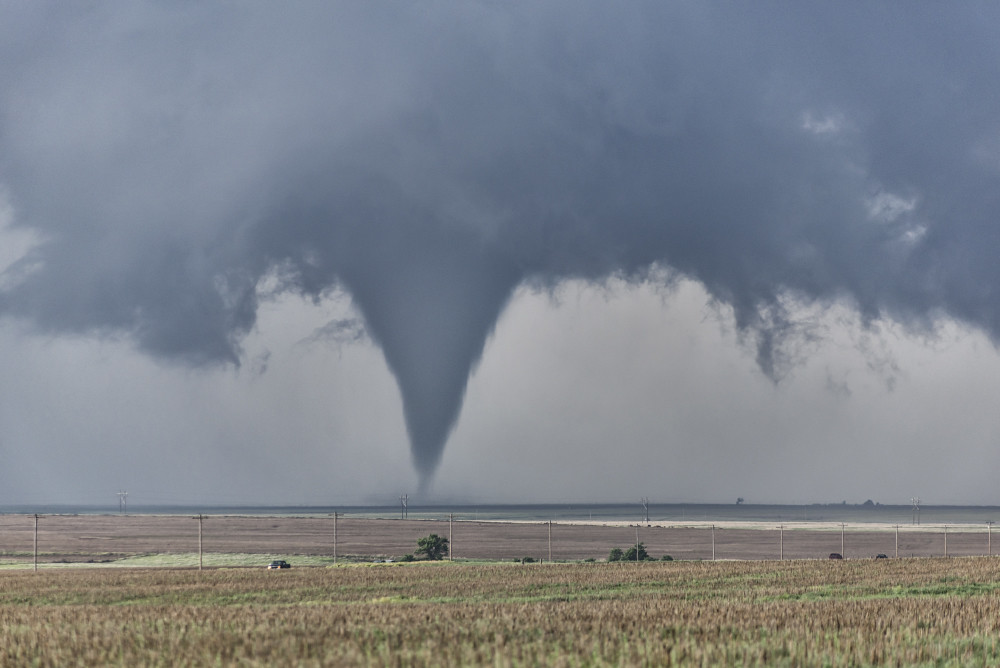In this post, we’re going to take a look at tornadoes, and more specifically answer a question we find many of our readers asking. Do tornadoes need flat land?
In a nutshell, no they do not. Although flat lands are optimal, tornadoes do not need flat land to form and can survive in valleys, hills, and mountains.
Tornadoes are some of the most dangerous natural weather phenomena on the planet. They are rapidly rotating columns of air that can cause destruction to anything in their path.
Let’s take a closer look…
Do Tornadoes Actually Need Flat Land?
Tornadoes do not need flat land to be able to survive, however, it is optimal for them as flat lands do not create any resistance against them.
When a tornado forms in the hills or mountains, trees, valleys, and rugged terrain can drain some of its power, making it weaker than if it was on a flat land surface.
That being said, if a tornado is large enough, it can easily pass through valleys, over rivers and nothing can stop it from its path.
When a tornado forms on flat land, it meets no resistance, meaning it can reach its maximum potential quickly.
“Tornado Alley” is a defined area in central America where tornadoes are most frequent and often the most violent.
Northern Texas, Oklahoma, Kansas, and Nebraska are all parts of Tornado Alley, and they are all high-risk zones when in tornado season.
How Are Tornadoes Formed?
The truth is, there is still a lot of debate about how tornadoes are actually formed. As the conditions that make one tornado form doesn’t necessarily cause others to form.
What we do know is that tornadoes begin with a thunderstorm, but not just an ordinary thunderstorm. The storms that brew up tornadoes are named supercells.
These supercell tornadoes can be as high as 50,000 feet and bring high-force winds, hailstones, and often flooding and other extreme weather with them.
But a supercell storm isn’t the only ingredient needed for a tornado to form. Rising air is the first ingredient that is needed for a tornado to develop.
Condensation is needed as it releases heat that drives huge upwards drafts of air, the more condensation and the bigger the storm clouds grow, the more powerful those updrafts become.
In supercells, this rising air mass is particularly strong, and as the air climbs, it changes direction and starts to move more quickly.
Finally, at the base of the storm, a huge cloud formation develops, which gives the tornado something to feed off later (if it forms that is).
When all of these ingredients are in place, a vortex can develop enclosed by the storm, forming a wide, tall tube of spinning air that gets pulled upwards, this is called a mesocyclone.
Outside, cool, dry seeking air starts to wrap around the back of this mesocyclone, forming what’s known as a rear flank downdraft.
This unusual scenario creates an unusual temperature difference between the inside of the mesocyclone and the outside, building up a level of instability that allows a tornado to thrive.
The mesocyclone’s lower part then becomes tighter, which increases the speed of the wind. If the funnel of air moves down to the cloud base at the bottom of the storm, it sucks it in and turns it into a rotating wall of cloud.
This forms a link between the storm and the earth, the second that tube of spinning cloud touches the ground it becomes a tornado.
Thankfully most tornadoes are small and short-lived, producing winds of around 65mph – 110mph, but others can last for over an hour and produce 200mph winds!
This is why it’s important for our weather technology to be able to detect tornadoes as soon as they start to occur.
Giving people enough time to evacuate and ensure they are safe and away from the tornadoes’ path of destruction.
Can Tornadoes Happen Anywhere?
Yes, if given the right conditions, tornadoes can happen anywhere, regardless of the terrain below.
That said, there are some areas where a tornado is much less likely to form, such as at high altitudes and up in the mountains.
The Appalachians are rarely hit by tornadoes, largely because the higher in altitude the colder the air becomes.
If you’ve ever climbed a mountain before then you will know that the higher you climb, the colder the air gets.
Colder air means more stability, meaning that tornadoes do not thrive in this environment as they need warm, moist air.
That said, just because these environments are not optimal for tornadoes does not mean that these altitudes and mountainous regions are immune from tornadoes.
in 1944 the Appalachians Tornado Outbreak was a deadly tornado outbreak that hit the midwest and mid-Atlantic regions of the US.
The outbreak produced multiple strong tornadoes in West Virginia, Maryland, and Pennsylvania – areas that were falsely believed to be immune to tornadoes.
Can Tornadoes Form In Valleys?
What about valleys, can tornadoes form in valleys?
Yes, they certainly can. Tornadoes are so strong that they can charge through valleys, cross rivers and traverse any landscape effortlessly.
In fact, the Great-Tri state tornado in 1925 was the deadliest tornado ever recorded and crossed the Mississippi River and Wabash Rivers.
No matter the landscape or terrain, a tornado is able to form in it and cross through it, which is part of what makes tornadoes be able to move so quickly and be so dangerous.
Final Thoughts
So, do tornadoes need flat land? Absolutely not. Flat lands are optimal for tornadoes due to less resistance, but they certainly don’t need it to survive.
There have been countless examples of tornadoes forming in valleys, mountains, and high-altitudes that many thought impossible.
The likes of Tornado Alley have the perfect mix of everything a tornado needs, dry, warm, humid air from the equator that fuels tornadoes.
This is why this area of the US sees the most tornadoes out of anywhere else, but there are tornadoes forming in unlikely environments all over the world on a regular basis.
Mother nature is an incredible force, when a tornado gets going, nothing can stop it.
Hopefully, this post has been insightful into tornadoes and you’ve learned something new today about how and where they form.
Thanks for taking the time to read this post, if you have enjoyed it feel free to stick around and learn some more about extreme weather and natural phenomenon.

Hey, I’m Sam – the founder of GustyPlanet. I’ve had a fascination with all things weather for as long as I can remember. I witnessed my first tornado at the age of 6, and since then became an avid storm chaser that is hooked on learning as much as I can about extreme weather. This blog was created to share my knowledge and to expand and delve deeper into the wonderful world of weather phenomena. I hope you enjoy your stay here and thanks for visiting.








